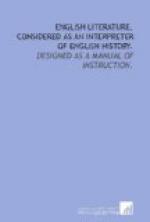These for a time divided the interest with the mysteries, but eventually superseded them. The impersonality of the characters enabled the author to make hits at political circumstances and existent follies with impunity, as the multitude received advice and reproof addressed to them abstractly, without feeling a personal sting, and the government would not condescend to notice such abstractions. The moralities were enacted in court-yards or palaces, the characters generally being personated by students, or merchants from the guilds. A great improvement was also made in the length of the play, which was usually only an hour in performance. The public taste was so wedded to the devil of the mysteries, that he could not be given up in the moral plays: he kept his place; but a rival buffoon appeared in the person of the vice, who tried conclusions with the archfiend in serio-comic style until the close of the performance, when Satan always carried the vice away in triumph, as he should do.
The moralities retained their place as legitimate drama throughout the sixteenth century, and indeed after the modern drama appeared. It is recorded that Queen Elizabeth, in 1601, then an old woman, witnessed one of these plays, entitled “The Contention between Liberality and Prodigality.” This was written by Lodge and Greene, two of the regular dramatists, after Ben Jonson had written “Every Man in his Humour,” and while Shakspeare was writing Hamlet. Thus the various progressive forms of the drama overlapped each other, the older retaining its place until the younger gained strength to assert its rights and supersede its rival.
THE INTERLUDE.—While the moralities were slowly dying out, another form of the drama had appeared as a connecting link between them and the legitimate drama of Shakspeare. This was the interlude, a short play, in which the dramatis personae were no longer allegorical characters, but persons in real life, usually, however, not all bearing names even assumed, but presented as a friar, a curate, a tapster, etc. The chief characteristic of the interlude was, however, its satire; it was a more outspoken reformer than the morality, scourged the evils of the age with greater boldness, and plunged into religious controversy with the zeal of opposing ecclesiastics. The first and principal writer of these interludes was John Heywood, a Roman Catholic, who wrote during the reign of Henry VIII., and, while a professed jester, was a great champion of his Church.
As in all cases of progress, literary and scientific, the lines of demarcation cannot be very distinctly drawn, but as the morality had superseded the mystery, and the interlude the morality, so now they were all to give way before the regular drama. The people were becoming more educated; the greater spread of classical knowledge had caused the dramatists to study and assimilate the excellences of Latin and Greek models; the power of the drama to instruct and refine, as well as to amuse, was acknowledged, and thus its capability of improvement became manifest. The forms it then assumed were more permanent, and indeed have remained almost unchanged down to our own day.




